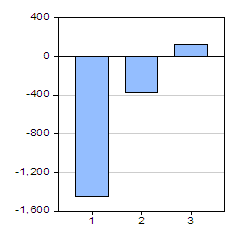What do current financial indicators tell us about where the economy is headed?
The Global Financial Crisis: Explaining Cross-Country Differences in the Output Impact
From “The Global Financial Crisis: Explaining Cross-Country Differences in the Output Impact,” IMF WP 09/280, by Pelin Berkmen, Gaston Gelos, Robert Rennhack, and James P. Walsh:
We provide one of the first attempts at explaining the differences in the crisis impact across
developing countries and emerging markets. Using cross-country regressions to explain the
factors driving growth forecast revisions after the eruption of the global crisis, we find that a
small set of variables explain a large share of the variation in growth revisions. …
Who Are You Going to Believe?
Professor Casey Mulligan says (and yesterday unequivocally reiterates) the stimulus program would not stimulate the economy. The nonpartisan CBO says otherwise:
…CBO estimates that in the fourth quarter of calendar year 2009, ARRA’s policies:
- Raised real GDP by between 1.5 percent and
3.5 percent,- Lowered the unemployment rate by between 0.5 percentage
points and 1.1 percentage points,- Increased the number of people employed by between
1.0 million and 2.1 million, and- Increased the number of full-time-equivalent jobs by
1.4 million to 3.0 million compared with what those
amounts would have been otherwise (see Table 1).
Crawling forward
Another month of weakly improving auto sales.
Net Fiscal Stimulus
From the abstract to “On the ease of overstating the fiscal stimulus in the US, 2008-9”, by (my sometime coauthor) Joshua Aizenman and Gurnain Kaur Pasricha:
This note shows that the aggregate fiscal expenditure stimulus in the United States, properly adjusted for the declining fiscal expenditure of the fifty states, was close to zero in 2009. While the Federal government stimulus prevented a net decline in aggregate fiscal expenditure, it did not stimulate the aggregate expenditure above its predicted mean. …
What Are These Three Numbers?
These numbers are expressed in billions of FY2010 dollars.

Figure 1, in billions of FY2010 dollars.
What drives media slant?
University of Chicago professors Matthew Gentzkow and Jesse Shapiro propose an answer.
Exports: Productivity, Factor Proportions, and Policy Implications
Bringing New Research Developments to Bear
The President’s goal of doubling exports elicited a lot of discussion, and skepticism. In a previous blog post, I examined the prospects of accomplishing this goal from a macroeconomic perspective. However, a few discussions I’ve had with journalists have reminded me that the frontier of international trade theory has moved considerably over the past few years, even as the much of the economic commentary remains mired in the older models. In this respect, the most recent edition of the Economic Report of the President was extremely welcome, as it brought to bear recent innovations in the trade literature.
Treasury Supplementary Financing Program (SFP)
The SFP, the U.S. Treasury’s program for assisting with the balance sheet of the Federal Reserve, is making a sudden and dramatic comeback.
Real Wage Decline Ended the 1981-82 Recession?
David Henderson writes in his “Reply to DeLong”:
In the 1981-82 recession, the fall in real wages helped end the recession.
I don’t see it in BLS series Nonfarm Business Sector: Real Compensation Per Hour.